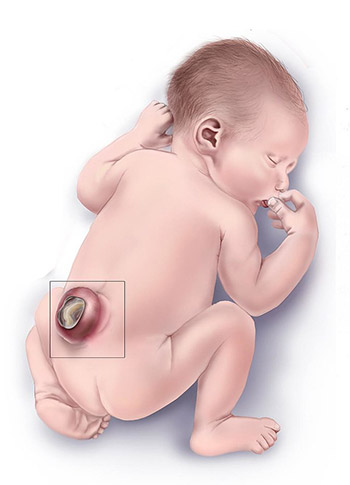Pay attention to skin lesions in your child's waist!
Hidden spina bifida (GSB) occurs as a result of impaired embryological development of the spine and spinal cord in the mother's womb. Open spina is a much mild congenital anomaly than bifida. Frequency of GSB in society varies between 10-20%. Most of the patients have no symptoms and are diagnosed during imaging for other reasons.
Some of the patients with GSB may have skin findings according to the level affected. In patients with skin findings, neurological functions are more likely to be affected. For this reason, if your child has a skin finding such as hair, redness, dimple, asymmetry, and sebaceous gland, it is very important to consult a neurosurgeon before it is too late. Neurological losses in children affected in this way may occur with height increase as the age progresses and may be permanent if not intervened in time.
Hidden spina bifida (GSB) occurs as a result of impaired embryological development of the spine and spinal cord in the mother's womb. Open spina is a much mild congenital anomaly than bifida. Frequency of GSB in society varies between 10-20%. Most of the patients have no symptoms and are diagnosed during imaging for other reasons.
Some of the patients with GSB may have skin findings according to the level affected. In patients with skin findings, neurological functions are more likely to be affected. For this reason, if your child has a skin finding such as hair, redness, dimple, asymmetry, and sebaceous gland, it is very important to consult a neurosurgeon before it is too late. Neurological losses in children affected in this way may occur with height increase as the age progresses and may be permanent if not intervened in time.
Varieties:
• Lipomyelomeningocele: It is the situation where the lower end of the spinal cord is attached to an oil gland.
• Thick Phylum To Terminal: The lower end of the spinal cord is thicker than it should be and is stuck below the level that should end.
• Oily Filum Terminal: There is a small oil gland inside the lower end of the spinal cord and it is stuck lower than the level that should be terminated.
• Discrete Cord Syndrome: It is the splitting of the spinal cord into two by a bone or cartilage piece.
• Dermal Sinus Canal: It is a channel between the spinal canal and the skin.
Signs and Signs:
People with GSB may not have any lifelong complaints, but progressive neurological function losses that occur during childhood can also be observed. The most common clinical picture is 'Tension Spinal Syndrome'. Tense spinal cord syndrome can occur in any of the above-mentioned types of GSB. It occurs as a result of stretching and damage to the spinal cord with the length of the child. Its main signs and symptoms,
• Low back and leg pain
• Weakness in the legs, early fatigue
• Feeling and sensory defects in the legs, burning, tingling
• Leg, foot and waist deformities
• Scoliosis
• Bladder and bowel problems (incontinence, chronic constipation ...)
Skin findings that can be seen in GSB,
• Excessive hair growth in the lumbar region
• Oil gland
• Hemangioma (red, purple-colored skin lesions)
• Color change in the lumbar region (dark color, red color and lighter colored lesions than the skin)
• Sacral dimple
• Canal opening from the waist area with liquid
If any of these skin findings are present, regardless of the age of the patient, neurosurgery should be applied as soon as possible, and the patient should be imaged with ultrasound (only in newborns) and MR.
Kiss. Dr. Huseyin CANAZ
Medilife Bağcılar Hospital
Brain and Nerve Surgery (Neurosurgery)
• Lipomyelomeningocele: It is the situation where the lower end of the spinal cord is attached to an oil gland.
• Thick Phylum To Terminal: The lower end of the spinal cord is thicker than it should be and is stuck below the level that should end.
• Oily Filum Terminal: There is a small oil gland inside the lower end of the spinal cord and it is stuck lower than the level that should be terminated.
• Discrete Cord Syndrome: It is the splitting of the spinal cord into two by a bone or cartilage piece.
• Dermal Sinus Canal: It is a channel between the spinal canal and the skin.
Signs and Signs:
People with GSB may not have any lifelong complaints, but progressive neurological function losses that occur during childhood can also be observed. The most common clinical picture is 'Tension Spinal Syndrome'. Tense spinal cord syndrome can occur in any of the above-mentioned types of GSB. It occurs as a result of stretching and damage to the spinal cord with the length of the child. Its main signs and symptoms,
• Low back and leg pain
• Weakness in the legs, early fatigue
• Feeling and sensory defects in the legs, burning, tingling
• Leg, foot and waist deformities
• Scoliosis
• Bladder and bowel problems (incontinence, chronic constipation ...)
Skin findings that can be seen in GSB,
• Excessive hair growth in the lumbar region
• Oil gland
• Hemangioma (red, purple-colored skin lesions)
• Color change in the lumbar region (dark color, red color and lighter colored lesions than the skin)
• Sacral dimple
• Canal opening from the waist area with liquid
If any of these skin findings are present, regardless of the age of the patient, neurosurgery should be applied as soon as possible, and the patient should be imaged with ultrasound (only in newborns) and MR.
Kiss. Dr. Huseyin CANAZ
Medilife Bağcılar Hospital
Brain and Nerve Surgery (Neurosurgery)



